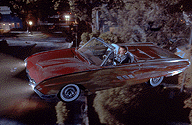

Behind the Scenes
FLUBBER - FX Credits - FX Review - Behind the Scenes - Stills
 back to page 4
back to page 4
Dream Quest Images was tapped to handle two major pieces of the visual effects pie of FLUBBER; the extensive flying Thunderbird sequences, and the CG Weebo shots. Helming the Dream Quest effort was Academy Award winner Doug Smith, veteran of INDPENDENCE DAY, STAR WARS, and Apogee Productions.
"I think it's impossible to tell which shots are the CG Weebo and the mechanical Weebo." Doug Smith
|
When the Professor's roving sidekick, the robot Weebo, couldn't be performed with the live-action mechanical puppet, Dream Quest provided a computer generated version of the yellow robot. "For the CG shots," Smith told me, "we were handed shots where it was impossible to recreate physically on the set with the mechanical Weebo. There's
a shot where Weebo gets hit with a bat, flies across the room and hits the wall, where it had to be done CG. It ended up being about ten shots, which had to cut directly with the mechanical, on set Weebo, created by Gary Pladdock and his team. I think it's impossible to tell which shots are the CG Weebo and the mechanical Weebo."
To make the CG Weebo look exactly like the real life machine, attention to the construction of the model and the creation of its textures were integral. Smith said, "We started with a rough schematic, and took a lot of photographs to build the Weebo model. Some of those photos were scanned to use as the basis of textures." Construction of the CG model happened during first unit photography, "so we couldn't actually scan or analyze the mechanical model at any great lengths," Smith said. "After shooting ended, we were able to get our hands on it, and make final changes to our CG model."

Dream Quest's background and Thunderbird element interacts with C.O.R.E's CG geese in this complicated shot from the flying sequence. |
The flying Thunderbird sequences would be produced via a complicated mixture of bluescreen elements, model miniatures, matte paintings, and CG elements. A the beginning of the process, Smith and Dream Quest shot a crude animatic, where all the camera moves would be determined. "Les [Mayfield] took that sequence, altered it a little, and it eventually became our moving storyboards." Shooting then commenced on fibre-filled clouds on stage, which were the basic building blocks of the cloud elements. "For the city down below," Smith said, "we occasionally used a matte painting, or in some cases, we used our 1/16 scale city miniature that we built. Into those shots, we put in CG wisps and more CG clouds. On some shots, where the camera move wasn't very elaborate, we did some 2D enhancements on top of the fiber clouds to make their edges a little more transparent. The process of making those clouds was intense, and I think they look very good in the picture."

The full size car makes its landing on the streets in this Dream Quest shot. |
As for the Thunderbird, many techniques were used to represent it--CG, full scale live-action bluescreen, and model miniatures. Smith remarked, "There's always a debate whether or not to create something like the Thunderbird in CG or in miniature, and it seems like each year that debate gets more and more difficult to settle. We knew we needed a model because in some shots, the car gets really close to the camera, and we knew our model could hold up to that kind of scrutiny. We also scanned the full size car to create our CG model, and it turns out that we used it in certain situations."
For shots of the full size car shot against a bluescreen, the car was shot without a windshield, to avoid stage and light fixture reflections. Dream Quest later replaced it with a CG windshield, complete with cloud and sky reflections. "We also composited reflections in the body of the car of the sky environment for those shots. It's interesting to note that the full size car was mounted on the same motion base that controlled the Harrier for TRUE LIES."
go to page 6 

. . VFX HQ Produced by Todd Vaziri . . http://www.vfxhq.com . . e-mail: tvaziri@gmail.com . .
All text Copyright © 1998 Todd Vaziri, unless otherwise noted




